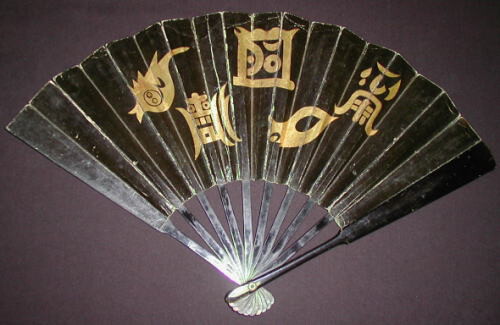-
Posts
2,459 -
Joined
-
Last visited
-
Days Won
21
Content Type
Profiles
Forums
Events
Store
Downloads
Gallery
Everything posted by Toryu2020
-

Missing one character on nengo (Shigetsugu, pics added)
Toryu2020 replied to SwordGuyJoe's topic in Translation Assistance
A rare date Joe - you really should share the rest of it if you have the chance... -t -

Translation and appraisal needed
Toryu2020 replied to hoobastank68's topic in Translation Assistance
John - Let me start by saying we have seen a lot more spent on a lot worse on this forum, so with very little knowledge, if I may say, you have done alright with your first purchases. If the responses here seem mixed it is because you ask a lot without seemingly heeded advice many times repeated on these pages. Imagine saying to your Iaido Sensei, I love your 300 year old art which you have spent decades mastering, "Can you teach me everything you know this weekend, I will send you a really big electronic thank you card if you do!" Since I am sure you are not that kind of student you'll understand if folks here think you should build a foundation first. Afterall Iaido is not just knowing how to draw but also when to draw. If you have a better grasp of the fundamentals you might find you are better equipped to make informed purchases. Ones that you will be happy with years from now. Also asking us to answer all of your questions is a bit like asking "Wheres the airport?" in a foreign language - you might get a long complicated answer you do not understand. For you to understand and learn from the answers given here it is best if you have a grasp of the lingo or at least references at hand that you can use to understand what is said. Hence "Books first, then swords!" Learn to describe your own swords using the accepted terminology - ask focused questions on the features you do not understand, I think you will be much more satisfied with the answers when your do. Take a look on line for the books of Markus Sesko - many of them are available as eBooks and will be good tools for your new hobby. You've taken a big first step, don't let the obstacles we've placed before you deter you, you have entered a world of study that is at least as much fun as drawing a sword... -t PS Sorry for all the Iai analogies couldn't help myself :D -
I might be looking at Kashu Kanewaka school - if I had to say this looks more like a yahazu-ba... -t
-
Grev - If you can see the five large "characters" in the image of the rubbing you are seeing it all. Basically they are representatives of the ancient form of the characters for North. South, East West that have been stylized to the point they look more like creatures. Since these characters represent the seat of the emperor this would have been a popular theme among those who studied Chinese classics or who espoused the cause of the Imperial house. -t
-
I would try a search for the following; The Five True Forms of the Five Sacred Mountains http://www.yijing.nl/i_ching/books/tai-shan.htm -t
-
Gabe - If the "Sword society" in your area is the one run by Harunaka Hoshino - run, do not walk, away from this deal. If your sword is worth anything now it will be worth nothing after his $700 polish. I may be biased but I suggest you attend a meeting of the Northern California Japanese Sword Club - our next meeting is tomorrow - see this link; http://www.ncjsc.org Anyone is welcome and you will receive fair, free and reliable advice as to next steps for your new sword. Bob btw is our newsletter editor... -t
-
Rich - I think I see the cloak of invisibility, the peach of eternal life, the lucky hammer of Daikoku and the key to eternal treasure house. if I didn't know better I'd say the theme here is "Treasure" FWIW -t
-
Junichi Look at Sasano Sukashi Sword Guards I believe he explains the state of ko-toehold and ko-katchushi quite well. -t
-
Axel - I think the only limit is size - if you want you can point us to a link, like a photobucket account then you dont have to upload all your photos one by one. The Hisayuki looks nice, count me as another hoping to see more... -t
-
-
Patrick - I have to say 655 was not that long ago - I guess I would not be surprised if I encountered one from 10 or more years ago. For you US Branch members out there this should be required reading! If you are not submitting for the Shijo Kantei you are not getting your money's worth... -t
-
城太郎光雄 Maybe?
-
I wonder did anyone else notice that this sword was a repeat? I only recently started seriously working these problems again and I am curious if this happens often? -t
-
I too am enjoying following this, I wonder have we jumped a step here - what about the basic construction of the piece itself - there was mention of the height of the design element - but what of the length, thickness and weight of the piece itself? What of the shape/size of the opening for the kogatana, what about how the piece is put together, one piece, two or three? Along with application/patination techniques is this not how we determine age? -t
-
james - it would be nice if we could see the tsuba too. i am just guessing but it looks like Akasaka Yasutoki saku - tetsu-ji hon sukashi The rest alludes me as well but will give it some more thought, thank you for the chance to work the little grey cells, -t
-
Och!?! Sorry, should read inch
-
Ken- What do you see when looking at the mune above the kissaki and an och or two below that? - t
-
Most likely a Daisho piece - the other tsuba depicting the tiger cub Tiger moms as we all know being extremely fierce. You might look at Ford Hallams pages for info on the theme and I think he produced one or two passable items in this vein... -t
-

Old wakizashi...? My first mei translation
Toryu2020 replied to Zoom Rabbit's topic in Translation Assistance
備州 ナントカ 丸 光兼 At first blush this is what I am seeing. Was not able to find a smith with these kanji in the Meikan. More and better pics will be needed. Jim - preservation is the watchword even for folks who do Iai, and I do hope you're not doing any yardwork with it... -t -
Darcy - This raises a more interesting question, Did Sato Sensei keep records? Where are those records kept now? Perhaps this is an avenue our friends at the NBTHK could help you explore... -t
-
Kyle - Would you have more pictures of the handle in question? Are there other mon on the item? Can we see the tsuba and habaki? Not likely but they may hold clues to place of origin. If anybody would know, David could tell you if the wrap was indicative and I dont think it is. Brocade on tsuka and saya were used very early on in some tachi koshirae and so is repeated in later years when recreating those early style of tachi. Brocade in place of same on buke-zukuri mounts like this seems to have been a late Edo thing and in most examples I have seen was a cost cutting thing on lower end items. Your piece looks to have had a hard life but I am sure it was quite eye-catching when fresh out of the shop. If this was the companion to a daito this fella would have been quite a dandy... -t
-
Gentlemen - The genesis of this story comes from the original name of this style of tsuba; Mukade. The Takeda army employed a troop of swift running messengers that carried orders from the command tent to the captains in the field; The Mukade-tai. They were conspicuous for their centipede hata-jirushi. When promoted to membership in this troop, the story goes, you were directly or indirectly given the privilege of wearing this style of tsuba, a mark of said membership, by the lord, Shingen himself. Why the tsuba? Because you did not wear the hata-jirushi every day, but you always had your sword! Reference Nihonto Daihyakka Jiten by Fukunaga Suiken I am pretty sure I wrote this up in To-Ron several years ago. Like any style it was oft copied and the "Shingen" appellation clearly excites us pedestrians more than "centipede tsuba", so it was natural for dealers to exploit it. The story clearly being lost over time... -t




